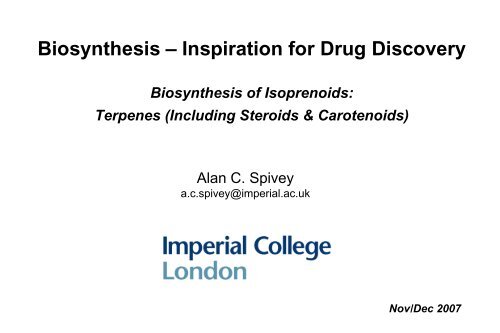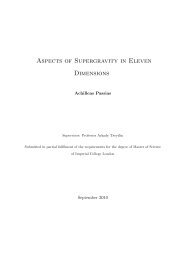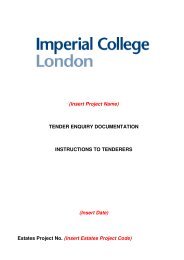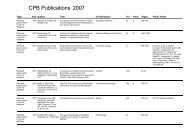lecture890708 - Workspace
lecture890708 - Workspace
lecture890708 - Workspace
Create successful ePaper yourself
Turn your PDF publications into a flip-book with our unique Google optimized e-Paper software.
Biosynthesis – Inspiration for Drug Discovery<br />
Biosynthesis of Isoprenoids:<br />
Terpenes (Including Steroids & Carotenoids)<br />
Alan C. Spivey<br />
a.c.spivey@imperial.ac.uk<br />
Nov/Dec 2007
• What are isoprenoids?<br />
Format & Scope of Lectures<br />
– n × C 5 diversity: terpenes, steroids, carotenoids & natural rubber<br />
– ‘the isoprene rule’<br />
– mevalonate & 1-deoxyxylulose pathways to IPP & DMAPP<br />
• Monoterpnes (C 10)<br />
– regular (‘head-to-tail’) via geranyl pyrophosphate<br />
– apparently irregular ‘iridoids’ (e.g. seco-loganin)<br />
• Sesquiterpenes (C 15)<br />
– farnesyl pyrophosphate derived metabolites<br />
– sesquiterpene cyclases: pentalenene, aristolochene & 5-epi-aristolochene<br />
• Diterpenes (C 20)<br />
– gibberellins & taxol<br />
• Triterpenes (C 30)<br />
– steroids (2,3-oxidosqualene → lanosterol → cholesterol → estrone)<br />
– ring-opened ‘steroids’: vitamin D 2 & azadirachtin<br />
• Carotenoids (C 40)<br />
– β-carotene, retinal & vitamin A
Isoprenoids<br />
• isoprenoids are widely distributed in the natural world<br />
– particularly prevalent in plants and least common in insects; >30,000 known<br />
– composed of integral numbers of C 5 ‘isoprene’ units:<br />
• monoterpenes (C 10); sesquiterpenes (C 15); diterpenes (C 20); sesterpenes (C 25, rare); triterpenes (C 30); carotenoids (C 40)<br />
HO<br />
H<br />
H<br />
OH<br />
n<br />
natural rubber (~10 5 x C 5)<br />
β-carotene (C 40)<br />
H<br />
OH<br />
cholesterol<br />
(C 27 but C 30-derived)<br />
O<br />
O OH<br />
HO<br />
humulone (2x C5) H<br />
O<br />
BzHN<br />
H H<br />
thujone<br />
(C 10)<br />
OH<br />
borneol<br />
(C 10)<br />
ISOPRENOIDS<br />
OPP<br />
dimethylallyl<br />
pyrophosphate<br />
(DMAPP)<br />
Ph<br />
O<br />
AcO<br />
HO O HO<br />
BzOAcO<br />
taxol (C20) isopentenyl<br />
pyrophosphate<br />
(IPP)<br />
O<br />
H<br />
OH<br />
O<br />
HO<br />
HO<br />
lavandulol<br />
(C 10) (Z)-α-bisabolene<br />
OPP<br />
H<br />
O<br />
H<br />
O<br />
CO 2H<br />
OH<br />
HO<br />
(C 15)<br />
O<br />
H<br />
O<br />
OH<br />
OH<br />
O<br />
H<br />
O O H<br />
O<br />
OH<br />
OH<br />
OH<br />
OH OH<br />
gibberellic acid (C 20)<br />
(gibberellin A 3)<br />
artemisinin (C 15)<br />
euonyminol (C 15)
Historical Perspective – ‘The Isoprenoid Rule’<br />
• Early 1900s:<br />
– common structural feature of terpenes – integral # of C 5 units<br />
– pyrolysis of many monoterpenes produced two moles of isoprene:<br />
• 1940s:<br />
• 1953:<br />
• 1964:<br />
• 1993:<br />
α-pinene (C 10)<br />
200°C<br />
– biogenesis of terpenes attributed to oligomers of isoprene – ‘the isoprene rule’<br />
– Ruzicka proposes ‘the biogenetic isoprene rule’ to accomodate ‘irregular’ terpenoids:<br />
• i.e. that terpenes were derived from a number of biological equivalents of isoprene initially joined in a ‘head-to-tail’<br />
manner & sometimes subsequently modified enzymatically to provide greater diversity of structure<br />
– Nobel prize awarded to Bloch, Cornforth & Popjak for elucidation of biosynthetic pathway to cholesterol<br />
including the first steps:<br />
• acetate → mevalonate (MVA) → isopentenylpyrophosphate (IPP) & dimethylallyl pyrophosphate (DMAPP)<br />
– Rohmer, Sahm & Arigoni elucidate an additional pathway to IPP & DMAPP:<br />
• pyruvate + glyceraldehyde-3-phosphate → 1-deoxyxylulose-5-phosphate → IPP & DMAPP<br />
Δ<br />
2x<br />
isoprene (C 5)
PO<br />
glycolysis<br />
CO 2<br />
phosphoenol pyruvate<br />
CO 2<br />
O<br />
pyruvate<br />
SCoA<br />
O<br />
acetyl coenzyme A<br />
CoAS<br />
O<br />
O<br />
acetoacetyl coenzyme A<br />
Primary Metabolism - Overview<br />
PHOTOSYNTHESIS<br />
Primary metabolism<br />
CO 2 + H 2O<br />
HO<br />
HO<br />
O<br />
HO<br />
HO<br />
OH<br />
glucose<br />
& other 4,5,6 & 7 carbon sugars<br />
+<br />
PO<br />
HO O<br />
OH<br />
erythrose-4-phosphate<br />
Citric acid<br />
cycle<br />
(Krebs cycle)<br />
1) 'light reactions': hv -> ATP and NADH<br />
2) 'dark reactions': CO 2 -> sugars (Calvin cycle)<br />
SCoA<br />
O<br />
malonyl coenzyme A<br />
HO<br />
CO 2<br />
HO OH<br />
OH<br />
shikimate<br />
aromatic amino acids<br />
aliphatic amino acids<br />
CO 2<br />
HO<br />
mevalonate<br />
CO 2<br />
Primary metabolites<br />
oligosaccharides<br />
polysaccharides<br />
nucleic acids (RNA, DNA)<br />
peptides<br />
proteins<br />
tetrapyrroles (porphyrins)<br />
saturated fatty acids<br />
unsaturated fatty acids<br />
lipids<br />
Secondary metabolites<br />
SHIKIMATE METABOLITES<br />
cinnamic acid derivatives<br />
aromatic compounds<br />
lignans, flavinoids<br />
ALKALOIDS<br />
penicillins<br />
cephalosporins<br />
cyclic peptides<br />
FATTY ACIDS & POLYKETIDES<br />
prostaglandins<br />
polyacetylenes<br />
aromatic compounds, polyphenols<br />
macrolides<br />
ISOPRENOIDS<br />
terpenoids<br />
steroids<br />
carotenoids
Biosynthesis of Mevalonate<br />
• Mevalonate (MVA) is the first committed step of isoprenoid biosynthesis<br />
– this key 6-carbon metabolite is formed from three molecules of acetyl CoA via acetoacetyl CoA:<br />
Claisen<br />
condensation<br />
aldol<br />
reaction<br />
then [R]<br />
2x NADPH<br />
O<br />
O<br />
SCoA<br />
SCoA<br />
CoAS<br />
O<br />
O<br />
acetoacetyl CoA<br />
HO<br />
O<br />
Primary metabolism<br />
O<br />
CoASH<br />
NAD<br />
CoASH<br />
SCoA<br />
CO 2<br />
HO<br />
mevalonate (MVA)<br />
CO 2<br />
2x CoASH<br />
2x NADP<br />
pyruvate GLYCOLYSIS<br />
CO 2<br />
NADH<br />
acetyl CoA<br />
O<br />
oxidative decarboxylation<br />
SCoA<br />
CO 2<br />
malonyl CoA<br />
CITRIC ACID CYCLE<br />
CO 2<br />
acetyl CoA carboxylase<br />
(biotin-dependent)<br />
carboxylation<br />
saturated fatty acids<br />
unsaturated fatty acids<br />
lipids<br />
Secondary metabolism<br />
FATTY ACIDS & POLYKETIDES<br />
prostaglandins<br />
polyacetylenes<br />
aromatic compounds, polyphenols<br />
macrolides<br />
ISOPRENOIDS<br />
terpenoids<br />
steroids<br />
carotenoids
Biosynthesis of IPP & DMAPP - via Mevalonate<br />
• IPP & DMAPP are the key C 5 precursors to all isoprenoids<br />
– the main pathway is via: acetyl CoA → acetoacetyl CoA → HMG CoA → mevalonate → IPP → DMAPP:<br />
DMAPP<br />
IPP<br />
O<br />
IPP isomerase<br />
(overall anti<br />
stereochemistry)<br />
Glu 207<br />
O<br />
O<br />
B-Enz<br />
SCoA<br />
SCoA<br />
CoAS<br />
H<br />
acetyl CoA<br />
OPP<br />
OPP<br />
H R<br />
Cys 139<br />
H s<br />
T<br />
H<br />
D<br />
T<br />
D2O S<br />
D<br />
H<br />
decarboxylative<br />
elimination<br />
P i + CO 2<br />
O<br />
Claisen condensation<br />
CoAS<br />
O<br />
PPO<br />
PO<br />
O<br />
Me<br />
O<br />
O<br />
O SCoA<br />
3x ATP<br />
3x ADP<br />
CoASH<br />
sequential addition<br />
H 2O<br />
CoAS<br />
O<br />
O<br />
CoASH<br />
2x NADPH 2x NADP<br />
HO<br />
O<br />
CoAS<br />
O<br />
CoAS HO<br />
HO<br />
CoASH<br />
acetoacetyl CoA<br />
aldol reaction<br />
CO 2<br />
CO 2<br />
hydroxymethylglutaryl CoA<br />
(HMG CoA)<br />
HMG CoA reductase<br />
RDS in cholesterol<br />
biosynthesis<br />
mevalonate (MVA)
HMG CoA reductase inhibitors - Statins<br />
• HMG CoA → MVA is the rate determining step in the biosynthetic pathway to cholesterol<br />
– 33 enzyme mediated steps are required to biosynthesise cholesterol from acetyl CoA & in principle the<br />
inhibition of any one of these will serve to break the chain. In practice, control rests with HMG-CoA reductase<br />
as the result of a variety of biochemical feedback mechanisms<br />
• ‘Statins’ inhibit HMG CoA reductase and are used clinically to treat hypercholesteraemia -a<br />
causative factor in heart disease<br />
R<br />
NADPH<br />
– e.g. mevinolin (=lovastatin ® , Merck) from Aspergillus terreus is a competitive inhibitior of HMG-CoA reductase<br />
N<br />
H 2N<br />
H<br />
H<br />
O<br />
O<br />
mevinolin (=lovastatin ® )<br />
PRO-DRUG<br />
NB. type I (iterative) PKS natural product<br />
O<br />
CoAS HO<br />
O<br />
OH<br />
HMG CoA<br />
O O<br />
CO 2<br />
OH 2<br />
in vivo<br />
NADP<br />
O<br />
HO<br />
O<br />
HO<br />
CoAS O<br />
H<br />
OH<br />
CO 2<br />
ACTIVE DRUG<br />
mimic of tetrahedral intermediate<br />
in HMG reduction by NADPH<br />
H<br />
CO 2<br />
Zn 2<br />
NADPH<br />
NADP<br />
CoASH<br />
HO<br />
HO<br />
mevalonate (MVA)<br />
H<br />
H<br />
HO<br />
H<br />
cholesterol<br />
CO 2<br />
PhHN<br />
O<br />
Ph<br />
i Pr<br />
N<br />
OH<br />
OH<br />
F<br />
CO 2<br />
LIPITOR
Biosynthesis of IPP & DMAPP – via 1-Deoxyxylulose<br />
• the mevalonate route to IPP & DMAPP has been proven in yeast & animals & in some plants & for<br />
a long while was believed to be the only pathway to these key intermediates<br />
– However, in some bacterial labelling studies:<br />
• no incorporation of mevalonolactone was observed<br />
• the pattern of label from glucose was inconsistent with derivation via catabolism to acetate<br />
• in 1993 an additional pathway to IPP & DMAPP was discovered:<br />
O<br />
– Rohmer et al. Biochem. J. 1993, 295, 517 (DOI)<br />
CO 2<br />
pyruvate<br />
DMAPP<br />
IPP<br />
+<br />
OPP<br />
OPP<br />
H<br />
O<br />
OH<br />
OP<br />
glyceraldehyde<br />
3-phosphate<br />
NADP<br />
NADPH<br />
DXP<br />
synthase<br />
HO<br />
CO 2<br />
O<br />
OH<br />
OH<br />
OP<br />
1-deoxyxylulose<br />
5-phosphate (DXP)<br />
OPP<br />
4-hydroxy-DMAPP<br />
NADP<br />
NADPH<br />
• The pathway is prevalent in many pathogenic bacteria and so its inhibition represents an exciting<br />
opportunity for antiinfective therapeutic development: Rohdich J. Org. Chem. 2006, 71, 8824 (DOI)<br />
HO<br />
H<br />
OH<br />
O<br />
OH<br />
OH<br />
DXP<br />
reductoisomerase<br />
O<br />
O<br />
P<br />
O<br />
P O<br />
O<br />
O O<br />
OP<br />
NADPH<br />
NADP<br />
CMP<br />
NB. CMP = cytidine monophosphate<br />
CTP = cytidine triphosphate<br />
HO<br />
HO<br />
ATP + CTP<br />
OH<br />
OH<br />
OP<br />
2-methyerythritol<br />
4-phosphate<br />
OP<br />
OH<br />
ADP + PP i<br />
O<br />
P<br />
O<br />
P<br />
O O<br />
O<br />
O<br />
O<br />
OH<br />
O<br />
N<br />
OH<br />
cytosine<br />
NH 2<br />
N<br />
O
Hemi-Terpenes – ‘Prenylated Alkaloids’<br />
• DMAPP is an excellent alkylating agent<br />
• C 5 units are frequently encountered as part of alkaloids (& shikimate metabolites) due to ‘latestage’<br />
alkylation by DMAPP<br />
– the transferred dimethyl allyl unit is often referred to as a ‘prenyl group’<br />
– ‘normal prenylation’ – ‘S N2’-like alkylation; ‘reverse prenylation’ – ‘S N2’-like alkylation<br />
4<br />
OPP<br />
• e.g. lysergic acid (recall the ergot alkaloids) – a ‘normal prenylated’ alkaloid (with significant subsequent processing)<br />
• e.g. roquefortine (recall diketopiperazine alkaloids) – a ‘reverse prenylated’ alkaloid<br />
N<br />
H<br />
'normal'<br />
prenylation<br />
cf. S N2<br />
HO<br />
tyrosine<br />
O H<br />
DMAPP<br />
N<br />
Me<br />
H<br />
N<br />
H<br />
lysergic acid<br />
(halucinogen)<br />
roquefortine<br />
(blue cheese mould)<br />
– review: R.M. Williams et al. ‘Biosynthesis of prenylated alkaloids derived from tryptophan’ Top. Curr. Chem.<br />
2000, 209, 97-173 (DOI)<br />
OPP<br />
3<br />
N<br />
H<br />
'reverse'<br />
prenylation<br />
cf. S N2'<br />
DMAPP<br />
tyrosine<br />
N<br />
H H<br />
N<br />
O<br />
O<br />
NH<br />
histidine<br />
H<br />
N<br />
N
Linear C 5n ‘head-to-tail’ Pyrophosphates<br />
• head-to-tail C 5 oligomers are the key precursors to isoprenoids<br />
– geranyl pyrophosphate (C 10) is formed by S N1 alkylation of DMAPP by IPP → monoterpenes<br />
– farnesyl (C 15) & geranylgeranyl (C 20) pyrophosphates are formed by further S N1 alkylations with IPP:<br />
evidence for S N1:<br />
F 3C<br />
OPP<br />
H*<br />
DMAPP<br />
H<br />
F 3C<br />
OPP<br />
S N1<br />
OPP<br />
ionisation is 1,000,000 times slower<br />
OPP<br />
OPP<br />
intimate ion pair<br />
H S H R<br />
IPP<br />
via<br />
OPP<br />
OPP inversion<br />
H R<br />
H S<br />
OPP<br />
*H<br />
OPP<br />
gerenyl pyrophosphate (C 10)<br />
farnesyl pyrophosphate (C 15)<br />
gerenylgeranyl pyrophosphate (C 20)<br />
H<br />
IPP<br />
IPP<br />
OPP<br />
OPP<br />
MONOTERPENES (C 10)<br />
SESQUITERPENES (C 15)<br />
TRITERPENES (C 30)<br />
DITERPENES (C 20)<br />
CAROTENOIDS (C 40)
Monoterpenes from Parsley & Sage<br />
Parsley (Petroselinum sativum)<br />
Sage (Salvia officinalis)<br />
apiol<br />
thujone<br />
α-pinene<br />
camphene
Monoterpenes from Rosemary & Thyme<br />
Rosemary (Rosmarinus officinalis)<br />
Thyme (Thymus vulgaris)<br />
camphor borneol cineol<br />
thymol carvacrol
1. S-(-)-limonene (lemon)<br />
2. R-(+)-limonene (orange)<br />
3. RS-(±)-limonene (pleasant)<br />
Limonene & Carvone<br />
Chiroscience plc. (now Dow Inc.)<br />
4. R-(-)-carvone (spearmint)<br />
5. S-(+)-carvone (caraway)<br />
6. RS-(±)-carvone (disgusting)
Monoterpenes – α-Terpinyl Cation Formation<br />
• geranyl pyrophosphate isomerises readily via an allylic cation to linalyl & neryl pyrophosphates<br />
– the leaving group abilty of pyrophosphate is enhanced by coordination to 3 × Mg 2+<br />
– all three pyrophosphates are substrates for cyclases via an α-terpinyl cation:<br />
OPP<br />
(E)<br />
OPP<br />
(Z)<br />
gerenyl<br />
pyrophosphate<br />
linalyl<br />
pyrophosphate<br />
OPP<br />
neryl<br />
pyrophosphate<br />
allylic cation<br />
intimate ion pair<br />
O<br />
O<br />
P O O<br />
Mg<br />
P O<br />
O<br />
O<br />
cyclase<br />
Mg<br />
initial<br />
chiral centre<br />
OPP<br />
=<br />
α-terpinyl cation<br />
OPP<br />
MONOTERPENES (C 10)
Monoterpenes – Fate of the α-Terpinyl Cation<br />
• The α-terpinyl cation undergoes a rich variety of further chemistry to give a diverse array of<br />
monoterpenes<br />
• Some important enzyme catalysed pathways are shown below<br />
– NB. intervention of Wagner-Meerwein 1,2-hydride- & 1,2-alkyl shifts<br />
E 1 elimination<br />
H 2O<br />
O<br />
b<br />
c<br />
H a<br />
H e<br />
thujone<br />
a<br />
limonene α-terpineol<br />
trapping with<br />
water<br />
OPP OPP<br />
d<br />
=<br />
c<br />
d<br />
α-terpinyl cation<br />
1,2-hydride shift<br />
H H<br />
e<br />
H<br />
b<br />
OH<br />
d<br />
c<br />
=<br />
trapping by alkene<br />
at 'red' carbon<br />
(anti-Markovnikov)<br />
trapping by alkene<br />
at 'blue' carbon<br />
(Markovnikov)<br />
H<br />
=<br />
H<br />
trapping by PPO -<br />
OPP<br />
1,2-alkyl shift<br />
E 1 elimination<br />
E 1 elimination<br />
H<br />
OPP<br />
bornyl<br />
pyrophosphate<br />
H<br />
hydrolysis [O]<br />
H<br />
E 1 elimination<br />
=<br />
OH<br />
O<br />
borneol camphor<br />
= =<br />
=<br />
=<br />
camphene<br />
β-pinene<br />
α-pinene
Apparently Irregular Monoterpenes<br />
• Apparently irregular monoterpenes can also occur by non-cationic cyclisation of geranyl PP<br />
derivatives followed by extensive rearrangement<br />
– e.g. iridoids – named after Iridomyrmex ants but generally of plant origin and invariably glucosidated<br />
• e.g. seco-loganin (recall indole alkaloids) is a key component of strictosidine - precorsor to numerous complex<br />
medicinally important alkaloids:<br />
tryptophan<br />
isoprene<br />
geranyl PP<br />
N<br />
H H<br />
H<br />
MeO 2C<br />
NH<br />
OPP OPP<br />
O<br />
strictosidine<br />
[O]<br />
P 450<br />
H<br />
OGlu<br />
10<br />
NH 2<br />
N<br />
H<br />
tryptamine<br />
H 2O<br />
enzymatic<br />
Pictet-Spengler<br />
reaction<br />
OH<br />
H<br />
MeO2C H 2O<br />
2x NADP<br />
2x NADPH<br />
O<br />
PP i<br />
secologanin<br />
H<br />
O<br />
OGlu<br />
H<br />
O<br />
O<br />
10<br />
10-oxo geranal<br />
NADPH<br />
NADP<br />
O<br />
OH<br />
unusual reductive ring-closure -> cyclopentane<br />
(NB. Non-cationic)<br />
unusual fragmentation<br />
[O] P 450<br />
=<br />
OH<br />
O<br />
HO 2C<br />
H2O HO<br />
MeO2C O<br />
OP<br />
OGlu<br />
ATP<br />
ADP<br />
HO<br />
H<br />
MeO2C H<br />
[O] P450 H<br />
OGlu<br />
methylation<br />
O<br />
SAM<br />
HO2C loganin<br />
O<br />
[O]<br />
P 450<br />
O<br />
OH<br />
OH<br />
glycoside<br />
formation<br />
O<br />
OGlu
Strictosidine → Vinca, Strychnos, Quinine etc.<br />
• The diversity of alkaloids derived from strictosidine is stunning and many pathways remain to be fully<br />
elucidated:<br />
MeO<br />
N<br />
N<br />
camptothecin<br />
MeO<br />
N<br />
H<br />
MeO2C O<br />
OH<br />
O<br />
O<br />
H<br />
HO<br />
MeO<br />
N<br />
quinine<br />
H<br />
N<br />
N<br />
H<br />
vinblastine<br />
(vinca)<br />
H<br />
OH<br />
N<br />
H<br />
Me<br />
N<br />
H<br />
OH<br />
CO2Me OAc<br />
N<br />
H H<br />
N<br />
H<br />
H<br />
MeO 2C<br />
H<br />
H<br />
MeO2C NH<br />
N<br />
ajmalicine<br />
(vinca)<br />
3<br />
H<br />
O<br />
strictosidine<br />
(isovincoside)<br />
Me<br />
N<br />
O<br />
N O<br />
H<br />
gelsemine<br />
(oxindole)<br />
H<br />
O<br />
OGlu<br />
N<br />
H<br />
H<br />
H<br />
MeO 2C<br />
N<br />
OH<br />
yohimbine<br />
O<br />
N<br />
H<br />
H<br />
N<br />
H<br />
H O<br />
strychnine<br />
(strychnos)<br />
H<br />
N<br />
H<br />
N H<br />
H<br />
aspidospermine<br />
(vinca)
Sesquiterpenes – Farnesyl Pyrophosphate (FPP)<br />
• ‘S N2’-like alkylation of geranyl PP by IPP gives farnesyl PP:<br />
geranyl PP<br />
OPP<br />
pro-R hydrogen is lost<br />
• just as geranyl PP readily isomerises to neryl & linaly PPs so farnesyl PP readily isomerises to<br />
equivalent compounds – allowing many modes of cyclisation & bicyclisation<br />
E,Z-FPP<br />
nerolidyl PP<br />
(E) (E) OPP<br />
E,E-FPP<br />
(E)<br />
(Z)<br />
OPP<br />
OPP<br />
OPP<br />
allylic cation<br />
intimate ion pair<br />
H S<br />
H R<br />
IPP<br />
OPP<br />
O<br />
O<br />
P O O<br />
Mg<br />
P<br />
O<br />
O<br />
cyclases<br />
O<br />
Mg<br />
6-memb<br />
10-memb<br />
11-memb<br />
ring cyclised<br />
'CATIONS'<br />
(E)<br />
E,E-farnesyl PP (FPP)<br />
OPP<br />
(E)<br />
- further cyclisation<br />
- 1,2-hydride & alkyl shifts<br />
- trapping with H 2O<br />
- elimination to alkenes<br />
vast array of<br />
mono- & bicyclic<br />
SESQUITERPENES<br />
NB. control by:<br />
1) enzyme to enforce conformation & sequestration of reactive intermediates<br />
2) intrinsic stereoelectronics of participating orbitals
Sesquiterpene Cyclases<br />
Christianson et al. Curr. Opin. Struct. Biol. 1998, 695 (DOI)
Terpene Cyclases – Control of Cyclisation<br />
• Functional aspects of terpenoid cyclases:<br />
– Templating: Active site provides a template for a specific conformation of the flexible linear isoprenoid starting<br />
material.<br />
– Triggering: Cyclase initiates carbocation formation.<br />
• Metal-assisted leaving group departure (e.g. pyrophosphate ionization aided by Mg 2+ )<br />
• C=C bond protonation (e.g. squalene-hopene cyclase, see later).<br />
• Epoxide protonation (e.g. oxidosqualene cyclase, see later).<br />
– Chaperoning: Chaperones conformations of carbocationic intermediates through the reaction sequence,<br />
ordinarily leading to one specific product.<br />
– Sequestering: Sequesters the carbocation intermediates by burying the substrate in a hydrophobic cavity that is<br />
generally solvent-inaccessible. Carbocations are concomitantly stabilized by the presence of aromatic residues in<br />
the active site that exert their effects via cation-π interactions<br />
RECALL:<br />
δ<br />
= δ<br />
δ<br />
δ on edges<br />
δ on faces<br />
– Adapted from: Christianson et al. Curr. Opin. Struct. Biol. 1998, 695 (DOI)<br />
• BUT:<br />
– individual terpene cyclases can give multiple products, see: Matsuda J. Am. Chem. Soc. 2007, 129, 11213 (DOI)<br />
R<br />
R<br />
R<br />
Enz<br />
cation - π<br />
stabilisation<br />
(~40-80 kJmol -1 )
Sesquiterpene Cyclase Crystal structures<br />
pentalenene synthase 5-epi-aristolochene synthase aristolochene synthase<br />
→ pentalenolactone (antibiotic) → fungal (myco)toxins (e.g. bipolaroxin, PR-toxin)
Aristolochene & 5-Epi-Aristolochene Synthases<br />
• molecular modelling studies indicate that the shape of the active sites determines the conformation<br />
of FPP and thus the stereochemistry of the final product<br />
– Penicillium roqueforti aristolochene synthase – Felicetti & Cane J. Am. Chem. Soc. 2004, 126, 7212 (DOI)<br />
PPO<br />
10-exo<br />
Phe-112<br />
E,E-FPP<br />
PPO H<br />
Phe-112<br />
germacrene A<br />
(+)-aristolochene<br />
H<br />
H<br />
– tobacco 5-epi-aristolochene synthase – Starks, Back, Chappell & Noel Science 1997, 277, 1815 (DOI)<br />
PPO<br />
cyclisation<br />
elimination<br />
H<br />
E,E-FPP<br />
Tyr–O<br />
cyclisation<br />
10-exo<br />
elimination<br />
1,2-alkyl<br />
shift<br />
TyrOH<br />
held by enzyme active site in different conformations from above<br />
(R)<br />
H<br />
H<br />
(S)<br />
H<br />
cation<br />
formation<br />
1,2-hydride<br />
shift<br />
H<br />
H<br />
transannular<br />
cyclisation<br />
eudesmane cation<br />
germacrene 5-epi-aristolochene
effects of gibberellin A 1 and<br />
brassinolide on rice seedlings<br />
Diterpenes - Gibberellins<br />
Dwarf rice<br />
seedlings (on the<br />
left) have a defect<br />
in the gibberellindependent<br />
signalling<br />
mechanism<br />
gibberellin A 20
H<br />
Diterpenes – Geranylgeranyl Pyrophosphate<br />
• S N2 alkylation of farnesyl PP by IPP gives geranylgeranyl PP:<br />
FPP<br />
OPP bicyclisation OPP cyclisation cyclisation<br />
H<br />
6-endo<br />
H<br />
6-exo<br />
H<br />
geranylgeranyl PP<br />
6-endo H<br />
labdadienyl PP<br />
H<br />
HO<br />
OPP<br />
• geranylgeranyl PP readily cyclises to give numerous multicyclic diterpenes<br />
– e.g. gibberellins – plant growth hormones<br />
H<br />
H<br />
O<br />
CO<br />
O 2H<br />
gibberellic acid<br />
(gibberellin A3) OH<br />
OPP<br />
• NB. cyclisation initiated by alkene protonation NOT loss of PPO -<br />
H<br />
HO 2C H CHO<br />
pinacol<br />
rearrangement (?)<br />
HO 2C<br />
H<br />
H<br />
H<br />
H<br />
OP<br />
• review: L.N. Mander ‘Twenty years of gibberellin research’ Nat. Prod. Rep. 2003, 20, 49-69 (DOI)<br />
H<br />
H<br />
IPP<br />
OPP<br />
gerenylgeranyl PP (C 20)<br />
OH<br />
1,2-alkyl<br />
shift<br />
4x [O]<br />
H<br />
H<br />
OPP<br />
H<br />
H<br />
kaurene<br />
elimination<br />
H
Diterpenes - Taxol
Diterpenes – Geranylgeranyl PP → Taxol<br />
• Taxol is a potent anti-cancer agent used in the treatment of breast & ovarian cancers<br />
– comes from the bark of the pacific yew (Taxus brevifolia)<br />
– binds to tubulin and intereferes with the assembly of microtubules<br />
• biosynthesis is from geranylgeranyl PP:<br />
OPP<br />
geranylgeranyl PP<br />
cyclisation<br />
14-exo<br />
– for details see: http://www.chem.qmul.ac.uk/iubmb/enzyme/reaction/terp/taxadiene.html<br />
– home page is: http://www.chem.qmul.ac.uk/iubmb/enzyme/<br />
OPP<br />
b<br />
H<br />
a<br />
H<br />
a<br />
b<br />
• recommendations of the Nomenclature Committee of the International Union of Biochemistry and Molecular Biology on the<br />
Nomenclature and Classification of Enzyme-Catalysed Reactions<br />
• based at Department of Chemistry, Queen Mary University of London<br />
BzNH<br />
HO<br />
Ph<br />
β-amino acid<br />
(shikimate)<br />
O<br />
O<br />
AcO<br />
HO<br />
BzO AcO<br />
cembrene<br />
O<br />
H<br />
OH<br />
O<br />
taxol<br />
sesquiterpene<br />
(isoprenoid)
Triterpenes – FPP → Squalene<br />
• triterpenes (C 30) arise from the ‘head to head’<br />
coupling of two fanesyl PP units to give<br />
squalene catalysed by squalene synthase:<br />
– squalene was first identified as a steroid precursor<br />
from shark liver oil<br />
– the dimerisation proceeds via an unusual mechanism<br />
involving electrophilic cyclopropane formation -<br />
rearrangement to a tertiary cyclopropylmethyl cation<br />
and reductive cyclopropane ring-opening by NADPH<br />
(NB. exact mechanism disputed)<br />
– Zaragozic acids (squalestatins) mimic a<br />
rearrangement intermediate and inhibit squalene<br />
synthase. They constitute interesting leads for<br />
development of new treatments for<br />
hypercholesteraemia & heart disease (cf. statins)<br />
O<br />
O<br />
HO2C zaragozic acid A<br />
(squalestatin S1) HO2C OH<br />
O<br />
O<br />
OH CO2H OAc<br />
FPP (acceptor)<br />
EnzB:<br />
squalene synthase<br />
H<br />
NADPH<br />
H<br />
H H<br />
H H<br />
H<br />
OPP<br />
OPP<br />
OPP<br />
OPP<br />
OPP<br />
OPP<br />
NADP<br />
FPP (donor)<br />
blocked by squalestatins<br />
+ PP i<br />
presqualene PP<br />
squalene
Triterpenes – Squalene → 2,3-Oxidosqualene<br />
• squalene is oxidised to 2,3-oxidosqualene by squalene oxidase – which is an O 2/FADH 2dependent<br />
enzyme:<br />
• the key oxidant is a peroxyflavin:<br />
O<br />
O O<br />
HN<br />
FADH 2<br />
squalene<br />
H<br />
N O<br />
NR<br />
NH<br />
O<br />
O<br />
O<br />
HN<br />
H<br />
N O<br />
NR<br />
peroxyflavin<br />
NH<br />
squalene<br />
oxidase<br />
O 2 + FADH 2<br />
H 2O + FAD<br />
reductive recycling<br />
O<br />
O<br />
HO<br />
H N<br />
O<br />
H<br />
N O<br />
NR<br />
N<br />
hydroxyflavin<br />
H 2O<br />
2,3-oxidosqualene<br />
O<br />
N<br />
FAD<br />
H<br />
N O<br />
NR<br />
N
Modes of Cyclisation of Squalene<br />
• all triterpenes (steroids, hopanoids etc.) are formed by the action of cyclase enzymes on either<br />
squalene or 2,3-oxidosqualene<br />
squalene oxidase<br />
O<br />
– i.e. different methods of ‘triggering’ cyclisation<br />
squalene<br />
2,3-oxidosqualene<br />
squalene<br />
cyclases<br />
triggering by<br />
ALKENE protonation<br />
oxidosqualene<br />
cyclases<br />
triggering by<br />
EPOXIDE protonation<br />
OH<br />
diplopterol H tetrahymanol<br />
HO HO HO<br />
H β-amyrin H cycloartenol<br />
STEROID/TRITERPENE NOMENCLATURE: β-face = top face (as drawn here)<br />
α-face = bottom face (as drawn here)<br />
H<br />
H<br />
H<br />
H<br />
H<br />
H<br />
H<br />
H<br />
H<br />
H<br />
OH<br />
H<br />
H<br />
H<br />
hopene<br />
H H<br />
= hydrogen up<br />
(on β-face)<br />
H<br />
H<br />
lanosterol<br />
= hydrogen down<br />
(on α-face)<br />
HOPANOIDS<br />
STEROIDS
Oxidosqualene-Lanosterol Cyclase (OSC)<br />
• oxidosqualene-lanosterol cyclase catalyses the formation of lanosterol from 2,3-oxidosqualene:<br />
– this cascade establishes the characteristic ring system of ALL steroids<br />
– until recently, as for SHC, the enzyme was believed to enforce a chair-boat-chair conformation to allow a<br />
concerted cationic ring-closure cascade followed by a series of suprafacial 1,2-shifts (shown below)<br />
– however, this requires anti-Markovnikov regioselectivity for the C ring-closure...<br />
HO<br />
O<br />
2,3-oxidosqualene<br />
H<br />
C<br />
lanosterol<br />
H<br />
OSC<br />
4x ring-closures<br />
2x 1,2-hydride shifts<br />
2x 1,2-Me shifts<br />
elimination<br />
O<br />
EnzB-H<br />
HO<br />
C ring-closure by<br />
anti-Markovnikov addition?<br />
H<br />
H<br />
H<br />
6-endo, 6-endo, 6-endo, 5-endo ?<br />
chair-boat-chair conformation ?<br />
prosterol cation<br />
NB all bolded bonds are anti-peri planar
Oxidosqualene-Lanosterol Cyclase – Mechanism<br />
• In fact, this process has also been shown to involve a Markovnikov ring-closure/1,2-alkyl-shift<br />
ring-expansion sequence to establish the C ring<br />
EnzB-H<br />
– again, the conformation enforced by the enzyme is NOT strictly a chair-boat-chair one (although probably<br />
very close), the process is NOT concerted, discrete cationic intermediates are involved &<br />
stereoelectronics dictate the regio- & stereoselectivity<br />
O<br />
2,3-oxidosqualene<br />
1) epoxide opening<br />
2) 2x Markovnikov<br />
ring-closures<br />
(6-memb rings)<br />
6-endo, 6-endo<br />
HO<br />
HO<br />
H<br />
H<br />
lanosterol<br />
H<br />
E 1 elimination<br />
Markovnikov<br />
ring-closure<br />
(5-memb ring)<br />
HO HO<br />
– “The enzyme’s role is most likely to shield intermediate carbocations… thereby allowing the hydride and<br />
methyl group migrations to proceed down a thermodynamically favorable and kinetically facile cascade”<br />
• Wendt et al. Angew. Chem. Int. Ed. 2000, 39, 2812 (DOI) & Wendt ibid 2005, 44, 3966 (DOI)<br />
5-endo<br />
HO<br />
H<br />
H<br />
H<br />
:BEnz<br />
H<br />
ring<br />
expansion<br />
(5 -> 6)<br />
1,2-alkyl shift<br />
1) 1,2-hydride shift<br />
2) 1,2-hydride shift<br />
3) 1,2-Me shift<br />
4) 1,2-Me shift<br />
(ALL suprafacial)<br />
5-endo<br />
H<br />
Markovnikov<br />
ring-closure<br />
(5-memb ring)<br />
H<br />
H<br />
HO<br />
H<br />
protosterol cation<br />
H
Lanosterol → Cholesterol – Oxidative Demethylation<br />
• Several steps are required for conversion of lanosterol to cholesterol:<br />
HO<br />
1<br />
4<br />
H<br />
5<br />
24<br />
8<br />
H<br />
5<br />
14<br />
H<br />
lanosterol<br />
8<br />
1) Δ 24 hydrogenation<br />
2) 14α DEMETHYLATION<br />
3) 4α & 4β DEMETHYLATION<br />
4) Δ 8 to Δ 5 rearrangement<br />
1) Δ 24 hydrogenation 2) 14α DEMETHYLATION<br />
NADPH<br />
24<br />
NADP<br />
3) 4α & 4β DEMETHYLATION<br />
HO<br />
4) Δ 8 to Δ 5 rearrangement<br />
4<br />
H<br />
4x O 2<br />
4x H 2O<br />
P 450<br />
O<br />
H<br />
O O<br />
isomerase<br />
CO 2<br />
H<br />
14<br />
H<br />
O<br />
H<br />
H<br />
NAD<br />
NADH<br />
HO<br />
H<br />
H<br />
H<br />
H<br />
[-> vitamin D]<br />
H<br />
4x O 2<br />
4x H 2O<br />
cholesterol<br />
2x O2 P450 H O2 P450 H<br />
H<br />
2x H 2O<br />
O<br />
O<br />
H<br />
HO<br />
=<br />
P 450<br />
NADH<br />
NAD<br />
O<br />
HO<br />
H :BEnz<br />
O<br />
O III<br />
Fe<br />
H<br />
O O<br />
HCO 2H<br />
H<br />
CO 2<br />
O<br />
flat, rigid structure<br />
H<br />
NADPH<br />
NADP<br />
NADPH<br />
H<br />
HO<br />
H<br />
NADP<br />
H<br />
H
Cholesterol → Human Sex Hormones<br />
• cholesterol is the precursor to the human sex hormones – progesterone, testosterone & estrone<br />
– the pathway is characterised by extensive oxidative processing by P 450 enzymes<br />
– estrone is produced from androstendione by oxidative demethylation with concomitant aromatisation:<br />
HO<br />
HO<br />
H<br />
H<br />
H<br />
cholesterol<br />
H<br />
H<br />
estrone<br />
(œstrone)<br />
H<br />
O<br />
H<br />
2x O 2<br />
2x H 2O<br />
HCO 2H<br />
P 450<br />
HO<br />
EnzB:<br />
Fe III<br />
O<br />
H<br />
H<br />
OH<br />
OH<br />
H<br />
H<br />
O<br />
O OH<br />
H<br />
H<br />
O 2<br />
O 2<br />
P 450<br />
O<br />
P 450<br />
HO<br />
DEMETHYLATIVE aromatisation by 'aromatase' enzyme<br />
O<br />
O<br />
H<br />
H<br />
H<br />
H<br />
H<br />
H<br />
O<br />
O<br />
H<br />
2x O 2<br />
NAD<br />
2x H 2O<br />
NADH<br />
P 450<br />
O<br />
O<br />
H<br />
H<br />
progesterone<br />
H<br />
H<br />
[O]<br />
H<br />
H<br />
X<br />
O<br />
H<br />
androstendione (X = O)<br />
testosterone (X = H, β−OH)
Steroid Ring Cleavage - Vitamin D & Azadirachtin<br />
• vitamin D 2 is biosynthesised by the photolytic cleavage of Δ 7 -dehydrocholesterol by UV light:<br />
HO<br />
– a classic example of photo-allowed, conrotatory electrocyclic ring-opening:<br />
H<br />
H<br />
H<br />
cholesterol<br />
H<br />
NADP<br />
NADPH<br />
HO<br />
H<br />
– D vitamins are involved in calcium absorption; defficiency leads to rickets (brittle/deformed bones)<br />
• Azadirachtin is a potent insect anti-feedant from the Indian neem tree:<br />
– exact biogenesis unknown but certainly via steroid modification:<br />
HO<br />
H<br />
7<br />
C<br />
OH<br />
tirucallol<br />
(cf. lanosterol)<br />
H<br />
Me<br />
7<br />
H<br />
H<br />
H<br />
O<br />
OH<br />
O<br />
AcO<br />
H<br />
AcO H<br />
H<br />
UV light (hv)<br />
electrocyclic<br />
ring-opening<br />
[6π]<br />
conrotatory<br />
OAc<br />
11 12<br />
OH<br />
azadirachtanin A<br />
(a limanoid =<br />
tetra-nor-triterpenoid)<br />
O<br />
H<br />
HO<br />
oxidative<br />
cleavage<br />
of C ring<br />
Me H<br />
H<br />
H<br />
ψ 4<br />
SOMO<br />
1,5-hydride<br />
shift<br />
O<br />
MeO2C O<br />
O<br />
OH<br />
O<br />
AcO OH<br />
MeO H<br />
2C O<br />
8<br />
azadirachtin<br />
14<br />
HO<br />
H<br />
vitamin D 2<br />
H<br />
O<br />
O<br />
OH<br />
highly hindered C-C bond<br />
for synthesis!<br />
[O]<br />
HO<br />
OH OH<br />
H<br />
OH<br />
H<br />
calcium ion chelator
Carotenoids – β-Carotene & vitamin A 1<br />
• Carotenoids (C 40) are coloured pigments made by photosynthetic plants & certain algae, bacteria &<br />
fungi. Dietary ingestion by birds and further processing gives rise to bright feather pigments etc.<br />
– biosynthesised by head-to-head coupling of two geranylgeranyl PP units to give lycopersene:<br />
GGPP (acceptor)<br />
prephytoene synthase<br />
PPO<br />
NADPH<br />
H<br />
OPP<br />
OPP<br />
[O]<br />
NADP + PP i<br />
GGPP (donor)<br />
prephytoene PP<br />
(cf. presqualene PP)<br />
lycopersene<br />
β-carotene<br />
– subsequent oxidative degradation (cf. ozonolysis!) gives retinal (mediator of vision) & vitamin A 1:<br />
11<br />
(E)<br />
retinal<br />
O<br />
vitamin A 1<br />
OH
PO<br />
glycolysis<br />
CO 2<br />
phosphoenol pyruvate<br />
CO 2<br />
O<br />
pyruvate<br />
SCoA<br />
O<br />
acetyl coenzyme A<br />
CoAS<br />
O<br />
O<br />
acetoacetyl coenzyme A<br />
PHOTOSYNTHESIS<br />
Primary Metabolism - Overview<br />
Primary metabolism<br />
CO 2 + H 2O<br />
HO<br />
HO<br />
O<br />
HO<br />
HO<br />
OH<br />
glucose<br />
& other 4,5,6 & 7 carbon sugars<br />
+<br />
PO<br />
HO O<br />
OH<br />
erythrose-4-phosphate<br />
Citric acid<br />
cycle<br />
(Krebs cycle)<br />
1) 'light reactions': hv -> ATP and NADH<br />
2) 'dark reactions': CO 2 -> sugars (Calvin cycle)<br />
SCoA<br />
O<br />
malonyl coenzyme A<br />
HO<br />
CO 2<br />
HO OH<br />
OH<br />
shikimate<br />
aromatic amino acids<br />
aliphatic amino acids<br />
CO 2<br />
HO<br />
mevalonate<br />
CO 2<br />
Primary metabolites<br />
oligosaccharides<br />
polysaccharides<br />
nucleic acids (RNA, DNA)<br />
peptides<br />
proteins<br />
tetrapyrroles (porphyrins)<br />
saturated fatty acids<br />
unsaturated fatty acids<br />
lipids<br />
Secondary metabolites<br />
SHIKIMATE METABOLITES<br />
cinnamic acid derivatives<br />
aromatic compounds<br />
lignans, flavinoids<br />
ALKALOIDS<br />
penicillins<br />
cephalosporins<br />
cyclic peptides<br />
FATTY ACIDS & POLYKETIDES<br />
prostaglandins<br />
polyacetylenes<br />
aromatic compounds, polyphenols<br />
macrolides<br />
ISOPRENOIDS<br />
terpenoids<br />
steroids<br />
carotenoids
















